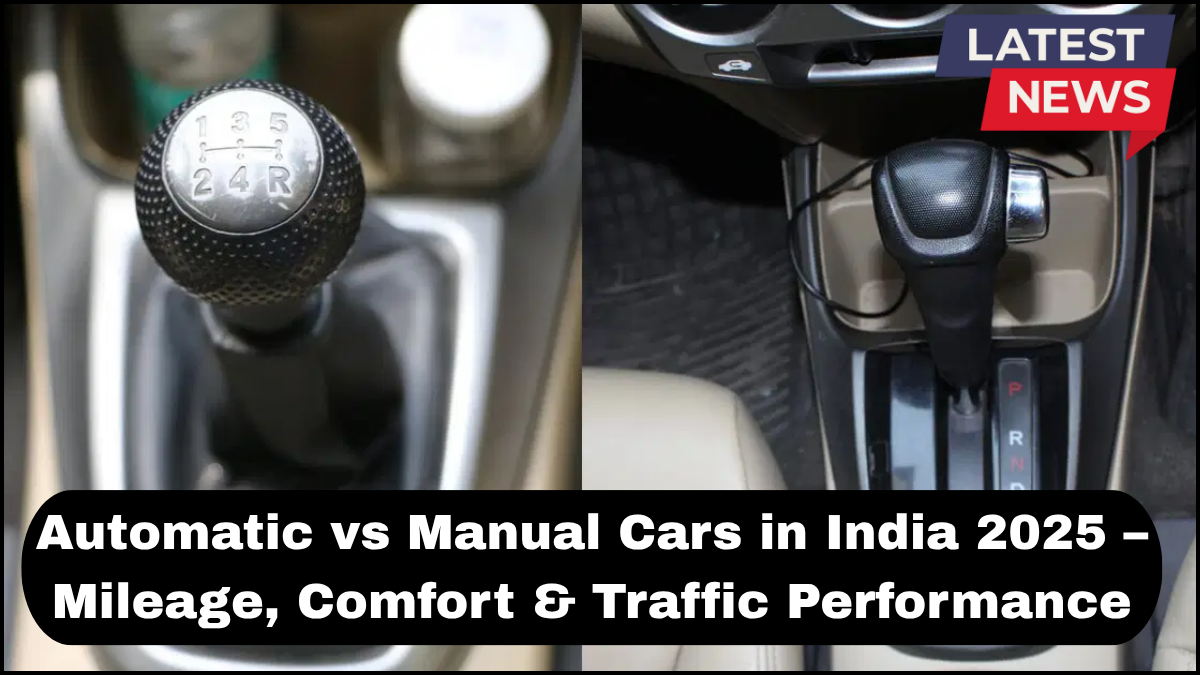As India continues to urbanize and car ownership grows, the debate between automatic vs manual cars in 2025 is more relevant than ever. Buyers are now more discerning—not just looking at price tags but also considering long-term comfort, fuel economy, and performance in daily traffic usage. This comparison aims to guide prospective car owners through key differences in mileage, drivability, cost, and suitability for Indian roads and driving habits.

Mileage: Which Transmission Offers Better Fuel Economy in 2025?
Fuel economy is a critical factor for Indian consumers, especially with rising fuel prices. Traditionally, manual cars had the upper hand in mileage. However, the landscape is shifting.
In 2025, many automatic transmissions—especially CVTs (Continuously Variable Transmissions) and AMTs (Automated Manual Transmissions)—are now finely tuned for efficiency. Modern automatic cars from brands like Maruti Suzuki, Hyundai, and Tata Motors are delivering mileage figures on par with their manual counterparts. For instance:
-
Maruti Baleno CVT (2025 model) delivers close to 22 km/l, while the manual version gives about 22.3 km/l.
-
Tata Punch AMT boasts a fuel efficiency of around 20.1 km/l, compared to 20.5 km/l for its manual sibling.
That said, manual cars still offer slightly better control over gear shifts, which can translate to marginal gains in fuel economy if driven optimally.
Verdict:
The fuel efficiency gap between automatics and manuals is narrowing. For most users, especially in city traffic, the difference is negligible.
Comfort: Automatic Cars Shine in Urban Driving
Driving in congested cities like Delhi, Mumbai, or Bangalore means dealing with stop-and-go traffic for hours. In this setting, automatic cars in 2025 are undeniably more comfortable.
With no need to press the clutch or shift gears constantly, automatic transmissions reduce driver fatigue dramatically. This makes them especially appealing for:
-
Daily commuters
-
Elderly drivers
-
First-time car owners
Features like hill assist, creep mode, and smoother gear transitions further enhance the comfort quotient of automatics. On the other hand, manual cars, while giving more control, demand more attention—making them less ideal for bumper-to-bumper traffic.
Verdict:
For ease of driving, especially in urban settings, automatic cars are the clear winner.
Traffic Performance: Automation Aces Congested Roads
When evaluating traffic usage, automatic cars once again take the lead. They adapt better to variable speeds and unpredictable traffic behavior. The latest dual-clutch and CVT systems in 2025 vehicles provide quick responsiveness and smooth acceleration.
Manual cars may offer better control on highways or hilly terrains, but in chaotic Indian city traffic, they require more frequent clutch use, leading to quicker wear and tear and increased driver stress.
Many Indian drivers now opt for AMT-based cars, which offer the benefits of both worlds: automatic ease with manual-like control when needed, all at a relatively affordable cost.
Verdict:
Automatic transmissions offer a more relaxed and efficient drive in high-traffic zones, making them ideal for Indian cities in 2025.
Cost Considerations: Are Automatics Still More Expensive?
Cost remains a sticking point for many buyers. In general, automatic variants are priced ₹50,000 to ₹1.5 lakh higher than manual versions. However, with growing demand and increased production, the price difference has reduced.
Plus, the lower physical strain, improved technology, and comparable fuel economy make automatic cars a more viable long-term investment, especially for city-centric drivers.
Resale Value and Maintenance
In 2025, the resale market for automatic cars in India has expanded. More buyers now seek automatics in the used car segment, improving their residual value. However, maintenance costs can be higher for some automatic gearboxes (especially DSGs), so it’s wise to research model-specific reliability.
When Manual Cars Still Make Sense
Despite all the benefits of automatics, manual cars remain a strong choice for:
-
Enthusiasts who enjoy full control over the drive
-
Rural or semi-urban areas where traffic is lighter
-
Budget-conscious buyers
-
Off-road or performance driving
In these scenarios, the engagement and mechanical simplicity of manual transmissions offer distinct advantages.
FAQs: Automatic vs Manual Cars in India 2025
Q1. Which is better for city driving – automatic or manual?
A: Automatic cars are better suited for city driving in 2025 due to reduced fatigue, smoother gear changes, and easier maneuvering in traffic.
Q2. Are automatic cars fuel efficient in India now?
A: Yes. With advancements in CVT, AMT, and dual-clutch systems, automatic cars in 2025 offer fuel economy nearly equal to manual ones.
Q3. Is the maintenance cost higher for automatic cars?
A: It depends on the transmission type. AMTs are cost-effective, while DSGs or CVTs may have slightly higher maintenance if not serviced regularly.
Q4. Do automatic cars have good resale value in India?
A: Absolutely. With increasing demand, automatics now command strong resale value, especially in metro cities.
Q5. Should I choose manual if I drive on highways more?
A: Yes. Manual transmissions offer better control and efficiency at high speeds, making them a good choice for highway driving.
click here to learn more
